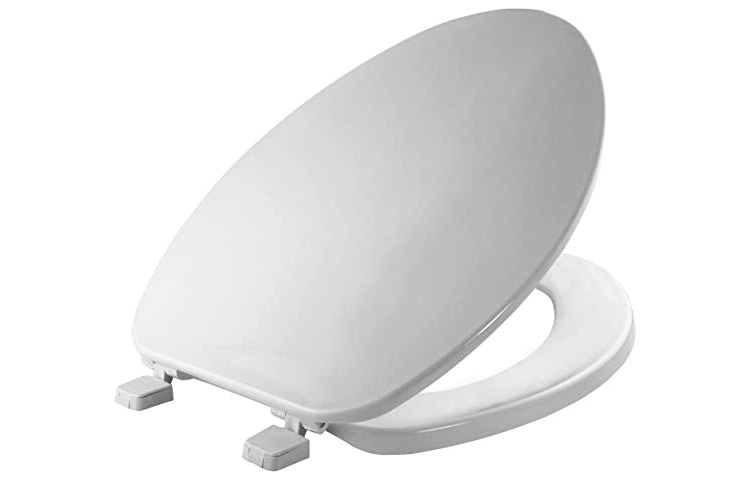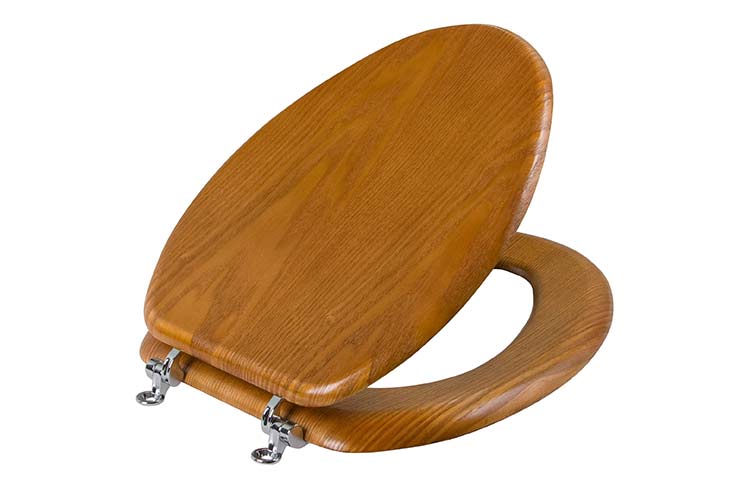Wood vs Plastic Toilet Seats: Which is the Best Choice?
Plastic and wood are the two most prevalent materials from which toilet seats are made. When compared, both of these materials have strengths and weaknesses. However, they’re readily available in the market, and they are durable and cost-friendly.
Generally, wood seats are strong, heavier, warm, and with a touch of style while plastic seats are lightweight, non-absorbent, and tend to last longer. If you’re looking to replace your seat or renovate your washroom, here is a detailed guide comparing plastic and wood toilet seats; features, pros, and cons
Plastic vs. Wood Toilet Seat: Differences
When deciding on whether to use plastic or wooden toilet seats, you’ll probably look for something that’ll fit your style, resonate with your budget, and offer the benefits you seek. So without further ado, let’s start the breakdown.
| SEAT FEATURES | WOODEN | PLASTIC |
| Durability | Natural Materials degrade faster | Last longer depending on the quality |
| Style | More classy and stylish(Enameled and Molded wood) | Looks Plain, Cheap and average |
| Scratches & Warping | Prone to scratches and warping | Scratch and warp resistant |
| Sanitary/Hygiene | Absorb liquids/smell not easy to clean | Non-absorbent and easy to clean |
| Comfort | Can retain Warmth | Uncomfortable in the cold season |
| Cost | Slightly Pricey | Pocket friendly |
| Maintenance | Can be re-varnished | Fades and cannot be re-varnished |
| Weight | Heavier | Light |
1. Comfort
Many of you spend a lot of time in the washroom, simply sitting there and going about with nature’s business. Which is why comfort is a top priority. Plastics are very weather dependent, which means the seat will be cold and flimsy in the winter and probably warm or cool in the months of summer.
Wood, on the other hand, doesn’t fluctuate with environmental temperatures. Their solid make regulates the feel; hence, the seat won’t be freezing during the winter.
2. Durability
Longevity stems from two areas;
- The make of the material
- Length of service
Wooden toilets have a win against plastic since they are manufactured more sturdy. They are thicker, heavier, and more weight resistant – also depending on whether it’s made using MDF (medium-density fiberboard) or engineered wood. Even so, they are less likely to break unless the connective pieces, such as the bidets, used to attach to the base of the toilet break first.
In terms of service, plastics offer better durability since wooden surfaces warp after extensive exposure to moisture in the washroom. Their protective coating will eventually wear down and be further susceptible to scratches on its finishing.
3. Pricing
Toilet seats can range from as low as $20 to ten times that amount. All these are attributed to the brand, material, style, and finishing added to the material, among other features.
In this case of plastic versus wood, plastic lies at the lower end of the spectrum. This is because the making of plastic seats isn’t as engaging as with wood. Besides, wood requires selecting the type of wood first – from oak, teak, and even exotic varieties, which you’ll pay extravagantly to be manufactured.
4. Sanitation
The toilet (washroom generally) should be the second most hygienic room in the house – after the kitchen. That being said, the question of whether wooden toilet seats are sanitary is common among homeowners.
Wood is a porous material; hence, one might argue that germs are more likely to hide under the seats. But that’s mostly the case for the unfinished wood.
Most wooden toilet seats come laminated or coated with a sealant to keep the dirt, mold, and germs away, besides protecting the wood. However, the sealant can wear down, which then poses a sanitary issue.
Plastic, on the other hand, is non-porous, which means cleaning is easy. One swipe with a sanitary wipe and all is well and clean. Also, plastics don’t wear down with water.
5. Appearance
Aesthetically, one look at the toilet seat and your decision is made. While it’s all a matter of preference, plastic is more modern simply by its appearance. It gives off a clean finish that fits most if not all bathrooms.
Wood, however, is more traditional. Set to suit a farmhouse look, a hobo style, or a slightly contemporary design. The wooden decor blends well with warm colors or a subtle look in your washroom.
6. Weight
You already know that wood is more sturdy than plastic. Well, yes, wood can hold up the weight to over 300 pounds. Its density makes it heavier and break-resistant than plastic.
However, in terms of opening and closing the lid, wood will require extra effort, unlike plastic, which is lighter.
7. Material preference
The choice is between plastic and wood, but you also have the option of which type of plastic or wood you want to have in your toilet.
Plastics can be in two forms – Thermoplastic or Thermoset. Thermoplastic can be reheated and remolded time and time again, which makes it more durable but expensive. Thermoset is heated and molded only once, but its scratch-resistant, therefore, equally durable.
Furthermore, plastics offer a wide array of designs such as luxury soft close seats, which is noise-free, protective of injuries by slamming fingers in between, and fast opening and closing. Finally, they offer a range of colors to choose from.
This is not to say wood doesn’t have a variety of options, it does. You can have wood seats that have been coated or painted with enamel paint.
It can be shaded using multiple hues, you can select various kinds of wood depending on your preference, and finishes can also be tuned to your liking.
8. Wear and Tear Resistance
You will spend a considerable amount of time in the toilet, which means you need something of value. Scratches are common especially if you have kids, hence plastic will be a better option here – specifically thermoset.
Wood isn’t a bad option either except the sealant you use to protect it from such wear and tear marks will eventually warp, leaving it susceptible to damage.
If you’re not looking to repeatedly seek repair, remold or remodel your toilet; simply choose the thermoset plastic.
Are Plastic Toilet Seats Better than Wooden Toilet Seats?
After comparing the two materials, it’s not unlikely that you’re still not sure which one to pick. Worry not, here’s a detailed look at each one of them.
Plastic Toilet Seats
The primary advantage of plastic seats is the ease of cleaning. Not only is it fast, but it’s also cost-friendly in that, you can use homemade remedies available in your pantry to clean it out. For example lemon, baking soda or powder, coke, and borax.

All these ingredients contain the main component – citric acid which deeply cleans and even bleaches plastic surfaces. So with very little effort, your toilet is left sparkling clean.
Second, plastic is cheaper than wood. Unless there are additional features you seek, you can’t compare its price to that of an oak wood toilet seat. They are easy to manufacture and readily available in the market for all interested buyers.
Another feature that could encourage you to lean towards getting a plastic seat is the weight, and especially if you have children. Plastic seats are easy to lift – soft opening and closing, and effortless to handle.
Pros
- A wide range of options to select in terms of design, color, and style.
- Light in weight
- Stain and scratch-resistant
- Cost friendly
- It doesn’t warp even with extended exposure to water.
- Easy to clean.
Cons
- They are prone to discoloration over time to either yellow or brown.
- Very weather dependent
- They have a subtle appearance
Wooden Toilet Seats
The most impressive feature of wood is its make – the heaviness and sturdiness it offers make it very long-lasting. Not only does it mean it can be used in almost all households, but it also means it hardly ever breaks due to exerted pressure.

Wooden toilet seats can be made from MDF or engineered wood that’s molded and coated for a shiny finish. The molding is done by gluing two or several pieces of wood together, which is then curved into the shape of a toilet bowl. After the seat has been carved, heated polystyrene is injected into the mold and left to cool.
Soon afterward, it’s coated with enamel to add a layer of strength as well as add a stylish finish/ polish. This makes it undeniably the most weight-resistant material regardless of whether it’s enameled, molded, or simply pure wood.
Another excellent feature of wooden toilet seats is that they are eco-friendly. They can be repurposed from various pieces of natural wood and used to preserve and conserve the environment causing no form of pollution.
Finally, they are comfortable. Not by being able to carry your weight, but because they maintain regular temperatures, regardless of the environmental conditions. This means even in the winter, you won’t be sitting on cold hardwood.
Further Reading: Pros and Cons Wooden Toilet Seats
Wood or Plastic Toilet Seat for a Heavy Person?
A wood toilet seat may be a better option compared to a plastic one
Editor’s Verdict
The choice between plastic or wood remains a question of personal preference. Nonetheless, from the intensive review above, wood tends to offer more advantages over disadvantages than plastics. They are aesthetically beautiful, they are sturdy, long-lasting, and offered in multiple colors and designs, plus aren’t hard to maintain. This makes them a better choice.
More Ideas on Toilet Seats
- How to Remove a Toilet Seat-Hidden Fixings, Metal Hinges & No Screws
- How to Tighten Loose Toilet Seat
- How to Raise a Toilet Seat
- Best Toilet Seats for the Elderly/Seniors +Guide
- Toilet Seat Types
- Different Toilet Seat Shapes and Sizes
- Round Toilet Seat, Dimensions, Pros & Cons
- Best Heated Toilet Seats (Battery and Non-Battery Operated)
- How to make a Heated Toilet Seat + Warmers DIY Ideas
- Dealing with a Yellowed Toilet Seat